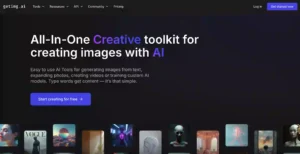AI Tools and Their Reviews: Understanding the Big Picture
Artificial Intelligence (AI) tools aren’t just about futuristic robots or machines acting like humans. They’re about tapping into technology that can learn, adapt, and improve the tasks we do every day. From recommending a perfect movie for your Saturday night to enhancing your company’s workflow, AI tools are everywhere. How do we know which ones are worth our time? User reviews and feedback form a crucial checkpoint, guiding us toward better decisions in this crowded marketplace.
In this journey, we’ll dive into the heart of AI tools, explore their real-world impact, and understand how user reviews influence their selection. Ready for a deep-dive into this ever-evolving tech landscape? Let’s get started!
Defining AI Tools in Simple Terms
AI tools are software solutions that mimic certain aspects of human intelligence. They learn from data and, over time, adjust their behavior based on outcomes. Think of them like digital apprentices always eager to pick up new skills.
The Role of Algorithms and Data in Ai Tools
At the core of AI tools are algorithms—step-by-step instructions that sift through data. Data is the fuel that powers an AI engine. If you have a social media feed that magically shows posts you’d likely enjoy, that’s an AI tool sorting through billions of posts to find the ones that match your preferences. Each time you click “like,” you feed it more data, teaching it what you find interesting.
Everyday Examples of AI Tools
Ever use a smartphone’s face unlock feature? That’s computer vision recognising your unique features. What about those online shopping recommendations that seem oddly specific? That’s machine learning analysing your browsing habits and matching them with similar products. AI tools aren’t confined to big tech; they’re steadily weaving into everything we do.
Why AI Tools Are Transforming Industries
It’s not a stretch to say that AI tools have reshaped how businesses think, plan, and grow. Whether we’re talking about tiny startups or massive corporations, AI adoption is on the rise—and for good reason.
Speed and Accuracy in Daily Operations
Picture an assembly line where machines perform quality checks at breakneck speed, identifying defects far more precisely than the human eye could manage. This level of accuracy translates to fewer product returns and happier customers. Additionally, AI-driven automation liberates human workers from repetitive tasks, letting them channel their energy toward creative, value-driven roles.
Personalised User Experiences
AI tools have a knack for learning user preferences. They analyse your behavior like what you watch, buy, or read—and then tailor your experience based on those patterns. This is why Netflix knows exactly which series to suggest next, and why e-commerce sites display items that perfectly match your recent searches. This hyper personalised approach often leads to higher engagement, loyal customers, and stronger word-of-mouth marketing.
Different Types of AI Tools
The AI ecosystem is vast, covering various subfields that cater to different needs. To get a clearer picture, let’s break down some of the most prominent categories.
Machine Learning Platforms
Machine learning platforms focus on enabling systems to learn from data and adapt over time. These platforms come loaded with algorithms you can fine-tune for your industry—be it healthcare, finance, or retail.
Supervised vs. Unsupervised Learning
Under the hood, machine learning typically falls into two main types. Supervised learning uses labeled data—like an email marked as spam or not spam—to train models. Unsupervised learning, on the other hand, deals with unlabelled data, letting the AI tool discover patterns without explicit guidance. Both are crucial depending on the complexity of your project.
Natural Language Processing Ai Tools
Words matter, and so do the subtleties in how we use them. NLP tools help machines understand and interact using human language. These tools can scour through oceans of text data—like chat logs or support tickets—and pinpoint the sentiment behind them or classify queries automatically.
Chatbots and Virtual Assistants Ai Tools
Chatbots thrive on NLP. Whether you’re asking a simple shipping question or trying to troubleshoot a technical issue, a chatbot can handle the basics, handing over complicated questions to a human agent only when necessary. Virtual assistants like Alexa or Google Assistant are more advanced, capable of recognising your voice and learning from past conversations.
Image and Speech Recognition Ai Tools
Visual data is enormous. From identifying objects in a photo to analysing video feeds in real-time, these tools rely on a branch of AI known as computer vision. Speech recognition goes hand in hand, enabling devices to transcribe spoken words or follow voice commands accurately.
Computer Vision Applications
Computer vision isn’t just about fun Instagram filters. Think about how self-driving cars detect pedestrians, or how drones can map disaster zones to help rescue teams. By converting images into data, AI tools can interpret the real world and make decisions on the fly, often faster than a human could.
AI Tools for Business Growth
Implementing AI effectively can serve as a game-changer for companies aiming to scale and innovate. It’s not just about tech-savvy giant corporations; small and medium-sized enterprises can also step up their game with well-chosen AI tools.
<strong”>Streamlining Customer Service
Outstanding customer service can be the deciding factor for many potential buyers. AI chatbots and ticketing systems instantly respond to user queries, offering quick fixes for common problems. This frees human teams to tackle complex issues where empathy and nuanced understanding matter. The result? Happier customers, shorter wait times, and a more engaged workforce.
Predictive Analytics for Market Insights
Trying to guess consumer trends by gut feeling alone is risky. AI-driven predictive analytics crunch multiple data sources—like social media mentions, buying histories, and even weather patterns—to forecast shifts in demand. This knowledge allows businesses to manage their inventory more efficiently, plan marketing campaigns strategically, and edge out the competition.
Balancing AI Automation with the Human Touch
Automation can do wonders, but it isn’t a universal fix. Certain tasks demand the warmth of human intervention—like building relationships with VIP clients or offering emotional support in healthcare settings. The ideal balance couples AI speed and data analysis with that distinctly human capacity for empathy and creative problem-solving.
Imagine a scenario where an AI algorithm suggests possible solutions to a customer complaint, but a skilled human representative takes it forward, adding a compassionate tone and personalised recommendations. That synergy is what makes AI truly valuable rather than a mere replacement for people.
The Importance of User Reviews in AI Tool Selection
Why trust reviews? Because they reveal a product’s true performance beyond the glossy marketing campaigns. Reviews help us gauge how well AI tools actually deliver on their promises, especially when used across diverse industry scenarios.
Reliability and Trust Factors
AI tools often handle sensitive data—like customer information, financial transactions, or medical histories. Reviews shed light on reliability issues: Do they crash under heavy traffic? How often do they update security protocols? A single negative review about data leaks can send prospective buyers running for the hills.
Feedback from Diverse Use Cases
AI tools that work brilliantly for retail might falter in the healthcare space. Reading reviews from people in different fields shows you the tool’s versatility or its limitations. It also offers insights on how easy it is to integrate the tool with existing systems—information you rarely get from a product brochure.
Common Criticisms and Limitations of AI Tools
No technology is perfect, and AI is no exception. While AI holds undeniable advantages, it also poses challenges that companies must address head-on.
Data Privacy Concerns
AI systems thrive on data, often personal details about users. When data privacy is compromised, trust evaporates. Regulations like GDPR underscore the responsibility companies have in safeguarding user data. Any slip-up invites legal troubles and erodes customer confidence.
Bias in AI Algorithms
An AI tool is only as good as the data it’s trained on. If that data carries historical biases—like underrepresenting certain groups—the tool can perpetuate those biases in its decisions. From hiring platforms to credit scoring tools, this can be a major ethical and reputational concern.
In-Depth Reviews of Popular AI Tools
When it comes to AI tools, not all are created equal. Each offers unique perks and, conversely, has specific drawbacks. That’s why diving into detailed reviews is so crucial.
Leading Chatbot Platforms
Platforms like Dialog flow, IBM Watson, and Microsoft Bot Framework often top the list in user reviews. Dialog flow gets praised for its intuitive interface, while IBM Watson excels at deeper analytics. Meanwhile, Microsoft Bot Framework shines in large enterprise setups. Keep an eye on factors like language support, ease of integration, and scalability when reading reviews.
Best ML Suites for Enterprises
Big players like Amazon SageMaker, Google Cloud ML, and Azure Machine Learning frequently battle for the top spot. SageMaker integrates neatly with other AWS services, a plus for companies already in the Amazon ecosystem. Google Cloud ML is praised for robust data handling, and Azure stands out for enterprise-friendly security measures. Reviews usually highlight how each platform handles real-time analytics, deployment complexity, and overall cost-effectiveness.
Popular Image Recognition APIs
Companies like Clarify, Google Vision, and Amazon Recognition claim to identify objects, scenes, and even sentiments in images. Reviewers often note the accuracy of detection, speed of processing, and how well these APIs handle tricky lighting or complex backgrounds. Some users rave about easy integration, while others find documentation lacking or face restrictions with free-tier usage.
Strategies for Reading and Interpreting AI Tool Reviews
We all know online reviews can be subjective. Some folks might trash an AI tool because they misunderstood the setup instructions. Others might sing praises because it solved one specific issue perfectly. So, how do you read between the lines?
- Look for Consistency: If multiple reviewers mention the same issue—like constant downtime—it’s probably a genuine problem.
- Focus on Your Use Case: A glowing review from the healthcare sector might not mean much if your business focuses on e-commerce.
- Check Reviewer Expertise: Reviews from data scientists can be more technical, pointing out limitations that a casual user might miss.
This balanced approach helps you make well-informed decisions, steering clear of both hype and unfair dismissals.
AI Tools in Emerging Markets
AI isn’t just for Silicon Valley. Countries across Asia, Africa, and South America are integrating AI tools in areas like agriculture, financial inclusion, and public health. In rural farming communities, AI-powered weather predictions can mean the difference between a bumper harvest and crop failure. Micro finance institutions use AI to assess credit risks, enabling small-scale entrepreneurs to access capital more easily. Watching how these emerging markets embrace AI can offer fresh perspectives on innovation.
Best Practices for Implementing AI Tools
Rolling out AI solutions isn’t plug-and-play. It’s a complex process that demands meticulous planning, a grasp of your business objectives, and continuous refinement.
Setting Clear Objectives
Before you invest in any AI platform, define what success looks like. Is your main aim to reduce customer service costs? Enhance product recommendations? Boost staff efficiency? Align your expectations with measurable goals so you can monitor progress effectively.
Involving Cross-Functional Teams
AI isn’t solely an IT department affair. It touches marketing, customer support, sales, and more. Collaborating across teams from the start ensures that the AI tool meets everyone’s needs, reducing friction and boosting adoption rates.
Continuous Evaluation and Update
AI models can become outdated if you let them sit idle. As user behaviors shift and market conditions evolve, your AI system needs regular updates. A well-maintained AI tool can offer valuable, real-time insights rather than stale data from six months ago.
Future Trends in AI Tools
Looking ahead, AI tools show no signs of slowing down. We’re seeing the rise of explainable AI, which clarifies how decisions are made—crucial for industries like finance and healthcare. Edge computing is also gaining traction, where data processing happens locally rather than relying on distant cloud servers, improving responsiveness and security.
Additionally, advanced Natural Language Generation (NLG) may open doors for AI to write more human-like articles, script dialogues, or craft personalised content for different user segments. The potential is enormous, but so are the ethical considerations.
Real-World Success Stories and Case Studies
Ever wonder how leading brands are using AI in the real world? Let’s peek at a few shining examples:
- Netflix’s Recommendation Engine: By analysing watch history, Netflix crafts personalised suggestions that keep viewers glued. This sophisticated algorithm reportedly saves the company billions in lost subscription revenue.
- Shopify’s Chatbot Integration: Shopify integrates AI chatbots for round-the-clock store assistance. Many small business owners love the feature for handling order inquiries and even suggesting upsells.
- Healthcare Diagnostics in Rural Clinics: Several pilot projects use machine learning algorithms to detect diseases from medical scans. The speed and accuracy help bridge the healthcare gap in remote regions.
These stories confirm that AI is far more than buzz; it’s enabling real solutions, forging new business models, and even saving lives.
Summary
AI tools are no longer a luxury but a fundamental asset in our increasingly data-driven world. From personalised customer interactions to accurate predictive models, these tools have the power to transform industries, empower startups, and even make our personal lives more convenient. However, selecting the right AI tool can feel daunting. That’s where user reviews step in, providing honest feedback and practical insights that cut through technical jargon.
Still, AI isn’t perfect. Issues like bias, data privacy, and ethical usage continue to loom large. Balancing automated efficiency with human warmth is critical. The world of AI moves fast, and the best approach is to stay informed—read widely, test relentlessly, and always stay open to new possibilities.
As AI tools continue to evolve, their potential for shaping the future is boundless. So if you’re on the fence about introducing AI into your workflow, there’s no better time to explore, experiment, and see for yourself how these tools can redefine your perspective on productivity and innovation.
FAQs
- How important are user reviews when picking an AI tool?
Reviews can provide real-world context, revealing both strengths and weaknesses that marketing materials might overlook. They’re an excellent way to determine if an AI tool meets your specific needs. - Do AI tools pose a risk to data privacy?
They can if not managed responsibly. Always opt for tools that use secure data practices and adhere to regulations like GDPR. Reading user reviews often uncovers any red flags related to privacy. - Will AI replace human jobs entirely?
AI can automate repetitive tasks, but it often creates new roles—like machine learning engineers or data analysts. Overall, it aims to enhance rather than outright replace human capabilities. - Are free AI tools worth trying out?
Free versions can be a good starting point, especially for small businesses or individual users. However, they may have limitations on features or data usage, so weigh your needs against the tool’s constraints. - How do I ensure my AI tool remains current and accurate?
Regularly update and retrain your AI models. AI algorithms need fresh data to maintain or improve accuracy, especially in fast-changing markets like e-commerce or social media analytics.
- How important are user reviews when picking an AI tool?
Trending Tools
Namelix, Promptbase, Prompthero, Ideogram ai, Remaker ai, Leonardo ai, Dezgo, Opus clip, Heygen Ai, Rendernet Ai, Videogen, Suno Ai, Gravitywrite, Udio, Outlier, Gamma Ai, Fabric Ai, Perplexity Ai, Invideo Ai, Harpa Ai, Arc Browser, Elevenlabs Ai, Deep Dream Generator, Claude Ai, Omi, Instantly Ai, D-ID Ai, Mojo Ai, Rytr Ai, Runway Ai, Jasper Ai, Descript, Simplified Ai, Humata Ai, Openart Ai, Deepseek, Zebra Ai, Adobe firefly apk, Coinrule, 3commas, Cryptohopper, Octobot, Cryptohero, Janitor Ai, Poly Ai, Ask Ai, Merlin Ai, Fireflies Ai, Agentgpt Ai, Turboscribe, Krea Ai, Blackbox Ai, Pixverse Ai, Hailuo Ai, Alaya Ai, Murf Ai, Quillbot Ai, Lovo Ai, V0 Dev, Writesonic Ai, Bubble io,Deadshot io, Recraft Ai, Getimg Ai, Stylar Ai
invideo ai, harpa ai, arc browser, elevenlabs ai, deep dream generator, claude ai, omi, instantly ai, d-id ai, mojo ai, rytr ai, runway ai, jasper ai, descript, simplified ai, humata ai, openart ai, turboscribe






